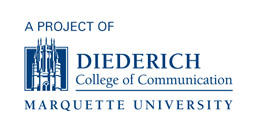Smiling little faces light up the spacious art room in Lindsay Heights’ Brown Street Academy on a recent cloudy day. Excited chatter, barely suppressed giggling and some hopping, skipping and jumping energize the space. Mosaic artist Leann Wooten mixes a pail of cement-like goo — properly called grout — that the children soon squish through their fingers.
Teacher Audrey Baur-Thompson’s first-graders lean in for a closer look and run their hands over the image of a bear formed from brightly colored bits of glass and tiles glued to a 3-foot-square board. Five mosaics resting on nearby tables depict a fish, deer, loon, eagle and crane, each representing a core value of America’s native people – truth, wisdom, love, honesty, respect and humility.
Video photos by Sue Vliet
The mosaics, representing four weeks of work by six classes of Brown Street elementary students will be mounted on permanent display around the building. They are part of a larger, multi-disciplinary Native American-themed project coordinated by Arts@Large, a local non-profit organization dedicated to bringing arts education to K-12 students, mostly in the city of Milwaukee.
Like almost every public school in Milwaukee, Brown Street no longer has an art teacher or any other “specials” teachers. It lost its part-time art teacher in 2009, according to Principal Ava Morris.
Morris’s response has been to search for resources outside the school system. “My mantra is that I want to see my students have experiences that they don’t otherwise have access to, being in the inner city. It has been my job and my duty to tap into other resources in the community — like Arts@Large and the Urban Ecology Center — that will provide my students with a variety of experiences,” Morris said.
With a college minor in drama, Morris said she is well aware of the importance of the arts in learning. And Brown Street consciously incorporates into its curriculum the notion that children have differing cognitive abilities and that each student learns in a unique way. When Morris heard about Arts@Large from colleagues at a nearby school, she aggressively pursued the collaboration, writing the grant request herself, she said.
The mission of Arts@Large, founded in 2001, is to foster equality of opportunity for all Wisconsin children by bringing arts education to schools that have none. It chooses schools where the administration, faculty and staff are willing to work to integrate the arts into their regular academic program and promote an arts-rich environment. The organization pairs diverse visual, literary, performing and multimedia artist educators with students for a three-year period, the optimum length of time needed to bring about lasting change, according to program coordinator Ryan Hurley.
In 2009/10, the last year for which figures are available, Arts@Large served more than 10,866 students at 24 MPS and two Eau Claire schools.
Though enhancing academic achievement is a key aspect of the group’s mission, it doesn’t yet have quantitative data to demonstrate the impact of arts education on student performance. “I know it, the teacher knows it and the students know it, but we don’t yet have data,” Hurley said.
Hurley noted, however, that a recent research survey that asked students about their feelings toward school, their peers and themselves found that the Arts@Large program improved all three. He added that there also is a lot of anecdotal evidence that arts education improves school climate, student behavior and students’ feelings about being in school.
Hurley cited the example of a student at Milwaukee’s Nova School, where Arts@Large artists initiated spoken-word poetry and photography clubs. Students in the two clubs decided to try to improve the way their city and neighborhood often are portrayed by collaborating on a project that represented them in a more positive light. After the student joined the poetry club this year, his school attendance improved dramatically and his GPA rose from .7 to 2.4. “His experience in the club helped him become highly engaged and feel like a valuable member with something to contribute,” Hurley said.
So that the Brown Street students can each “own” a piece of the mosaic, Wooten had them work independently at their desks in the initial stages. They created their own flowers on wire mesh and then glued them on to the board supporting the larger mosaic. Offering the highest compliment a 7-year-old can give, Daron Howard said making the mosaic has been “awesome.”





